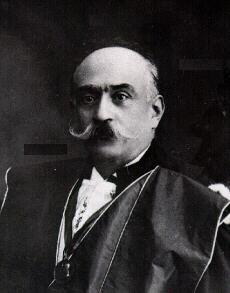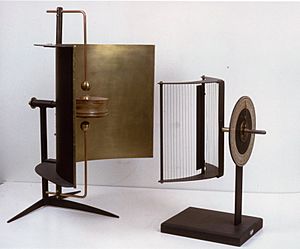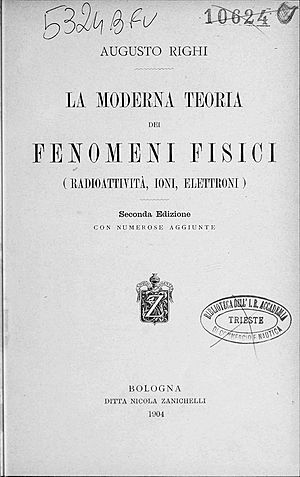Augusto Righi facts for kids
Quick facts for kids
Augusto Righi
|
|
|---|---|
 |
|
| Born | 27 August 1850 Bologna, Italy
|
| Died | 8 June 1920 (aged 69) Bologna, Italy
|
| Alma mater | University of Bologna |
| Known for | Induction electrometer, Microwaves, Magnetic hysteresis |
| Awards | Matteucci Medal (1882) Hughes Medal (1905) |
| Scientific career | |
| Academic advisors | Antonio Pacinotti |
| Notable students | Guglielmo Marconi |
Augusto Righi (born August 27, 1850 – died June 8, 1920) was an important Italian physicist. He was a pioneer in studying electromagnetism, which is how electricity and magnetism are connected. Righi was born and died in Bologna, Italy.
Contents
Who Was Augusto Righi?
Augusto Righi was born in Bologna, Italy. He studied physics in his hometown. From 1873 to 1880, he taught physics at Bologna Technical College. Later, he became a professor at the University of Palermo. He also taught at the University of Padua from 1885 to 1889. After that, he returned to the University of Bologna as a professor. He worked there for the rest of his life.
Righi's Early Discoveries
Righi's first research was about electrostatics. This is the study of electric charges that are not moving. In 1872, he invented an induction electrometer. This device could find and make very small electric charges stronger. He also figured out how to describe vibrational motion using math. In 1880, he discovered magnetic hysteresis. This is when a material's magnetism depends on its past magnetic state.
While at the University of Palermo, Righi studied how heat and electricity move through a metal called bismuth. In Padua, he researched the photoelectric effect. This is when light makes electrons move from a material.
Exploring Radio Waves and Microwaves
One of Righi's most famous works was his study of Hertzian waves in the 1890s. These are also known as radio waves. They were first discovered in 1887.
In 1894, Righi was one of the first people to create microwaves. Microwaves are a type of radio wave with very short wavelengths. He made 12 gigahertz (GHz) microwaves using a special device called a metal ball spark oscillator. He then detected them with an antenna.
Righi used his spark transmitter and detector to perform classic optics experiments with microwaves. He used wavelengths of 20, 7.5, and 2.5 centimeters. He made quasioptical parts, prisms, and lenses from paraffin wax and sulfur. He also used wire diffraction gratings. With these, he showed how short radio waves can bend, spread out, and change their polarization.
His experiments proved that radio waves and light are both electromagnetic waves. They only differ in their frequency. This confirmed James Clerk Maxwell's theory from 1873. Righi's book, L'ottica delle oscillazioni elettriche (1897), summarized his findings. It is considered a very important book in experimental electromagnetism. In 1903, Righi also wrote a book about wireless telegraphy.
Righi's Influence on Guglielmo Marconi
Augusto Righi had a big influence on the young Guglielmo Marconi. Marconi is famous for inventing the radio. Marconi visited Righi in his lab. In 1894, Marconi used Righi's special four-ball spark oscillator in his transmitters. This helped Marconi invent the first practical wireless telegraphy radio transmitters and receivers.
Later Research
By 1900, Righi started working on X-rays and the Zeeman effect. The Zeeman effect is how a magnetic field splits light into different colors. He also studied gas under different pressures and how it becomes ionized. From 1918, he worked on improving the Michelson–Morley experiment. This experiment tried to find a special substance called "luminiferous aether."
See Also
 In Spanish: Augusto Righi para niños
In Spanish: Augusto Righi para niños
- Guglielmo Marconi
- Electromagnetism
- Righi–Leduc effect



